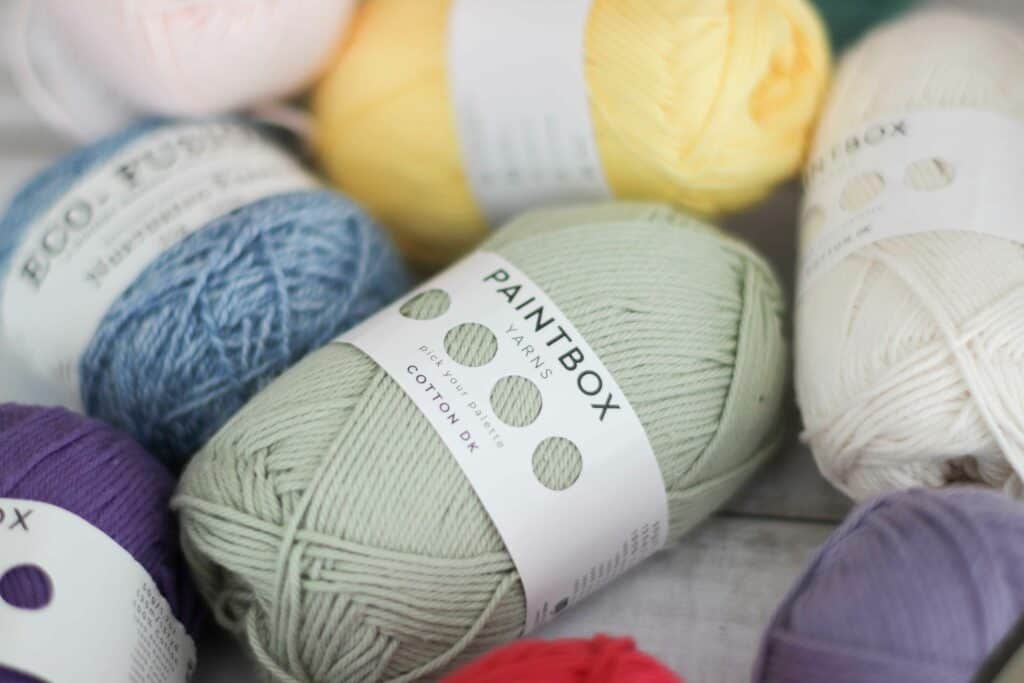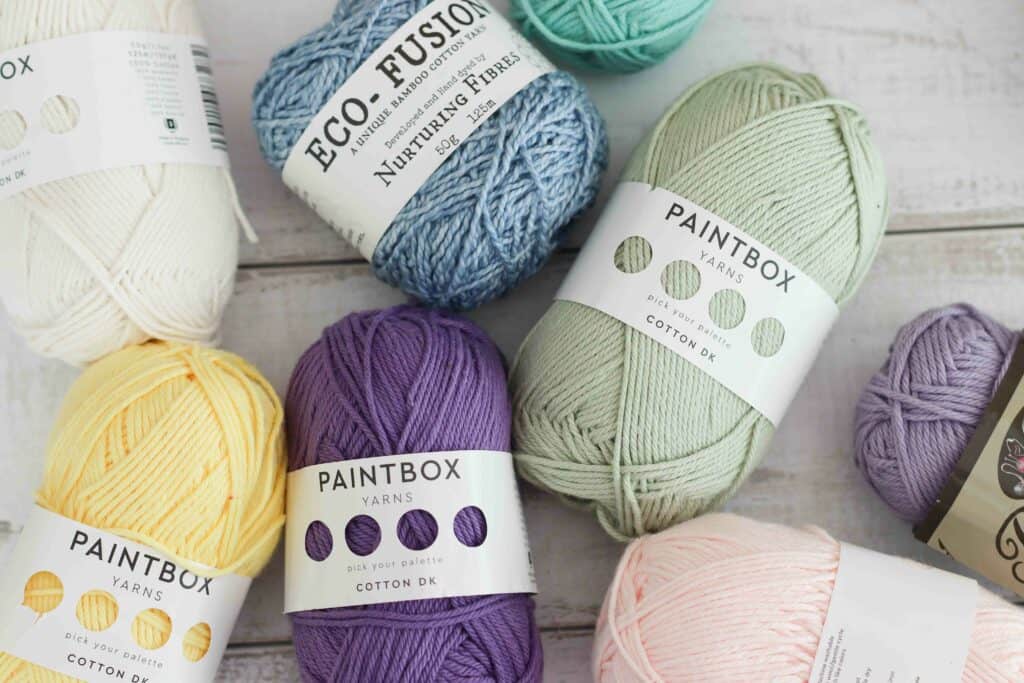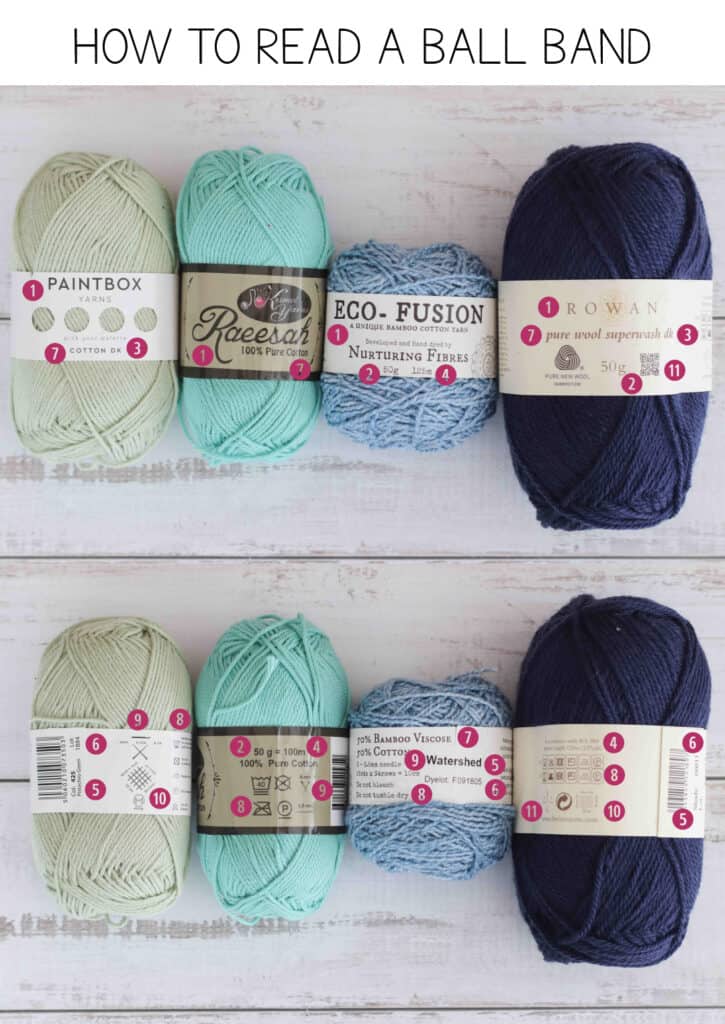The first question you may be asking is “what is a yarn ball band? And why is a yarn ball band important?”. Simply put, the yarn ball band is the strip of paper found wrapped around balls of yarn.
When I first started crocheting and purchasing yarn, I never used to take much notice of the yarn ball band. It was simply the piece of paper that held my yarn together. But in actual fact, there is a LOT of information hidden away on that strip of paper, and learning how to read a yarn ball band really will up your crochet game.

Below, I’ve listed all the information that can typically be found on ball bands. Note that not all bands will have all of this information, but should have most of it.
What to look out for when reading the yarn ball band.
1. Yarn Name
The ball band will include the name of the company as well as the name of the yarn line. Sometimes the name of the yarn line is very descriptive and gives a fair bit of information about the yarn itself. For example, the names Paintbox Cotton DK or Rowan Pure Wool Superwash DK are very descriptive, telling us the weight and fiber type of the yarn. And in the case of the Rowan yarn, how to care for the wool.
Other yarn brands (for example, Red Heart Super Saver) have names that are much less descriptive, so you will need to do a little more reading on the ball band to find out more about the yarn.
2. Ball weight
This is the actual weight of the ball of yarn, not the yarn weight or class. (Confused? Read this article about the difference between yarn weight and the weight of yarn). In other words, if the yarn ball band says that the skein weighs 50g, then if you were to place the ball of yarn on a scale, that’s how much it would weigh. Ball weight can be used to calculate yardage.
3. Yarn weight / class
Somewhere on the ball band will be a note about the yarn weight / class (or yarn thickness). In other words, if the yarn is classified as worsted weight, sports weight, bulky etc. It might be in the name of the yarn (e.g. Paintbox Simply DK) or there will be a separate note somewhere on the ball band. You may also see a little yarn ball icon with a number in it. The number will denote the yarn class (see reference table here)
There may also be a note on the yarn plies (i.e. how many twists, if any, the yarn has), although I find that this tends to be more on indie dyed yarns than on commercial yarns.
4. Yarn length
Yarn length means how many yards / meters of yarn you can expect in one skein. Be aware that not all balls of the same weight will have the same length yarn! Knowing the yarn length is very helpful when substituting yarn for bigger projects. Always make sure to calculate the actual length of yarn that you need.
For example, in the picture further down the page, all of the yarn balls weigh 50g and are the same weight (DK/light worsted). However, the turquoise ball only has 100m of yarn while the other three have approximately 125m per skein.
If you were to do a straight substitution and use the turquoise yarn instead of any of the other brands, you would be 25 meters of yarn short… per ball! This can really add up for larger projects. Are you starting to see why the yarn ball band is important?
5. Yarn color / shade
This is the name or code for the specific color of the yarn. It is worth taking note of the color name in the event that you need to purchase more yarn of the same color.

6. Dye lot / batch number
Whether in a large factory or a small indie enterprise, yarn is typically dyed in batches and each batch is given a unique code. While every effort is made to keep the colors consistent across batches, very small changes in the environment (such as the pH of the dye bath, the ambient temperature etc) can change the final color.
I definitely saw this happen when I tried to dye my own yarn at home (with avocado skins!!)
These color differences are not large by any means, but they can be noticeable.
If you are preparing for a single project, try and buy yarn that is from the same lot (i.e. with the same lot or batch number). Since all the yarn in one lot was dyed at the same time, it will be the exact same color. If you purchase the same color / shade in the future, there is a risk that there won’t be an exact match, and this color difference will show up in your project.
7. Fiber type and composition
The yarn ball band should always show you the composition of the yarn. Is it made of acrylic or of a natural fiber? Or a combination of both? It’s always good to look at this as the fiber you use for your project will affect the look and feel of your finished piece, as well as how to care for your project.
Not all yarns of the same fiber type will feel the same too! Knowing the fiber content is also important when substituting yarns.
8. Care instructions
Care instructions are often included on the ball band. Take note of these instructions, particularly if you are gifting your finishing make.
9. Hook / knitting needle size suggestion
The hook/needle information on a yarn ball band is a very good indication of what sized tools you should use. It is, however, just a guideline rather that a hard and fast rule! It’s always a good idea to make a small swatch to see if you need to adjust your hook or needle size.
10. Swatching information
Not all yarn ball bands include this information, and it is typically aimed more at knitters than crocheters. The swatching guide will tell you the estimated finished size of a swatch when using a certain needle size and working a certain number of rows.
11. Additional information on the yarn ball band
Very often the ball band includes a website address for the yarn company as well as details of where the yarn is made. There may even be a link to a free pattern!

1. Yarn brand name
2. Ball / skein weight
3. Yarn weight / class
4. Yarn length
5. Yarn color / shade
6. Dye lot / batch number
7. Fiber type and composition
8. Care instructions
9. Hook size suggestions
10. Swatching information
11. Additional information
